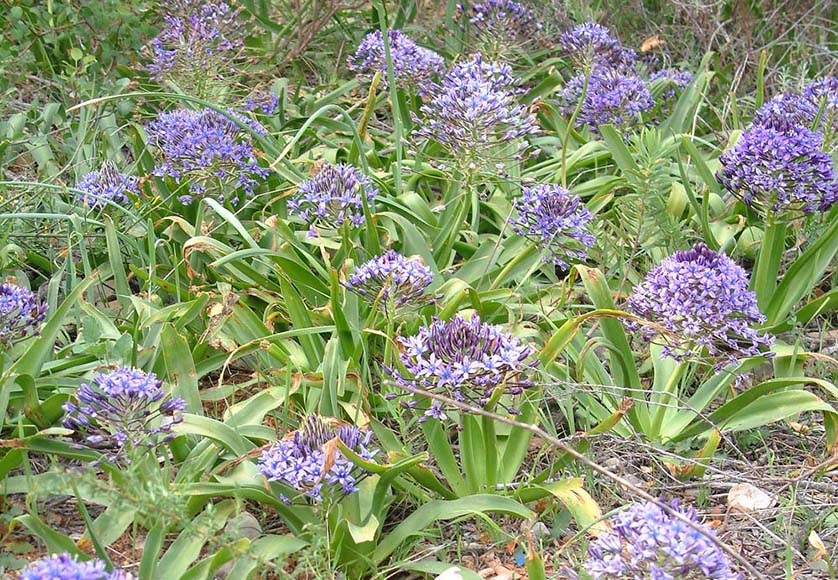September is the time of year when gardeners in the Mediterranean usually start thinking about planting bulbs for later autumn and spring colour.
Bulbous plants have had an important role in horticulture since the early centuries. Interest in them grew further when selected species were introduced into cultivation and breeding began.
Some plants became fashionable and highly desired: the tulip mania of the 17th century is the prime example of this, but hyacinths, bearded irises, Narcissus, Lilium and Gladiolus have all also had their moments of being the height of fashion. And fashions in bulbs continue today, with daffodils and tulips giving place to Galanthus (the snowdrop) and Crocus.
Bulbs have always been admired for their beauty and scent and, in the past, were quite easy to obtain as they could be collected in many parts of the Mediterranean, North Africa and Central Asia.
The advantage of their period of dormancy was that it made transport easier – a good example is Iris albicans which is native to Saudi Arabia and was introduced to the Mediterranean, Southern Europe and Asia by Muslim pilgrims coming back from Mecca.
This iris became particularly popular in Muslim graveyards for its white colour symbolising purity, for the importance of its place of origin and for the fact that no care is needed after the plant has become established. This iris is a common sight on Algarve roadsides and in gardens.
Similarly, Sternbergia lutea was introduced by Greek monks who carried the bulbs from their homeland and planted them in many of the monasteries spread around the Eastern Mediterranean. It also grows well in the Algarve and will follow the first rains with upright crocus-like yellow flowers. I cannot stress strongly enough, however, that today bulbs should never be dug up from the wild – indeed, in most countries, it is against the law to do so.
Many species need little attention after being planted, will thrive and with time form large clumps. Help newly-planted bulbs establish by giving an occasional feed with an organic fertiliser after flowering.
Bulbous plants are a good solution for places with difficult conditions, for isolated houses where water is either not available or too precious to be used for irrigation, or for geographic areas characterised by very hot and dry conditions or extremely cold winters.
The swapping of bulbs started in early times and continues today. Gardeners are usually generous people who will gladly spare a bulb or two. In this way, highly perfumed species such as Polianthes tuberosa (the tuberose), Lilium candidum and freesias are grown in pots or large metal tins at the entrances of houses and on balconies but are also popular in town gardens and urban balconies.
Today, bulbous plants are an important feature in the sustainable garden as they have an extended dormant season and require no watering. They are a great addition to an existing garden and often offer a lovely surprise when they flower. We are lucky to have many native bulbs suitable for our gardens. Scilla peruviana and Narcissus papyraceous are to be found in the Barrocal along the Algarve.
Here is a list of bulbous plants which I recommend for use in our Mediterranean gardens. The criteria for my choice of species are that, firstly, they need no irrigation, and they have a long flowering period, are resistant to diseases, moles etc. They provide a focal point at different seasons and, lastly, they are relatively easy to obtain from your local garden centre or nurseries, and, of course, by swapping with friends and neighbours.
Bulbs, Corms and Rhizomes for Mediterranean Gardens – online talk by John Fielding https://www.mgaportugal.org/JF_video.html
The MGAP Autumn Mediterranean Garden fair will have some of these bulbs available for sale on the MGAP stand, as well as many others for containers or garden planting. This year, it will be held in Estoi on Saturday, October 29 and Sunday, October 30 – www.mgaportugal.org for more info.
Recommended bulbs for Mediterranean gardens
Allium neapolitanum, A. Christophii
Amaryllis belladonna
Cyclamen persicum and C. graecum
Freesia refracta, F. leichtlinii and F. alba
Hispanica hyacinthoides
Ipheion uniflorum
Iris albicans
Iris foetidissima
Iris hollandicum
Narcissus papyraceous
Narcissus poeticus
Narcissus tazetta ‘Constantinopolitanus’ and ‘Double Roman’
Scilla peruviana
Sparaxis mix
Tulipa saxatilis
By Rosie Peddle
|| features@algarveresident.com
289 791 869 | mgapsec@gmail.com
facebook.com/MedGardenersPortugal
www.mgaportugal.org




















